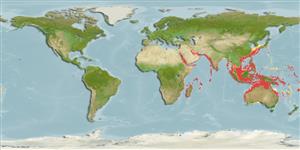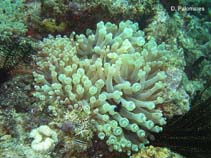Entacmaea quadricolor (Leuckart, 1828)
Bulb-tentacle sea anemone| Native range | All suitable habitat | Point map | Year 2050 |

|
| This map was computer-generated and has not yet been reviewed. |
| Entacmaea quadricolor AquaMaps Data sources: GBIF OBIS |
Classification / Names Tên thường gặp | Các synonym ( Các tên trùng) | CoL | ITIS | WoRMS
Hexacorallia | Actiniaria | Actiniidae
Environment: milieu / climate zone / Mức độ sâu / distribution range Sinh thái học
Cùng sống ở rạn san hô; Mức độ sâu 0 - 200 m (Tài liệu tham khảo 102444). Tropical
Distribution Các nước | Các khu vực của FAO | Các hệ sinh thái | Những lần xuất hiện | Những chỉ dẫn
Indo-Pacific: Micronesia and Melanesia to east Africa and the Red Sea and from Australia to Japan.
Length at first maturity / Bộ gần gũi / Weight / Age
Chín muồi sinh dục: Lm ? range ? - ? cm Max length : 40.0 cm WD con đực/không giới tính; (Tài liệu tham khảo 9810)
Short description Hình thái học
Life cycle and mating behavior Chín muồi sinh dục | Sự tái sinh sản | Đẻ trứng | Eggs | Sự sinh sản | Larvae
Main reference
Các tài liệu tham khảo | Người điều phối | Người cộng tác
Fautin, D.G. 2007 Hexacorallians of the World. http://geoportal.kgs.ku.edu/hexacoral/anemone2/index.cfm[accessed08/07/16] (Tài liệu tham khảo 77115)
IUCN Red List Status
(Tài liệu tham khảo 130435: Version 2025-1)
CITES status (Tài liệu tham khảo 108899)
CMS (Tài liệu tham khảo 116361)
Threat to humans
Human uses
| FishSource |
Các công cụ
Thêm thông tin
Thành phần thức ăn
Thành phần thức ăn
Các động vật ăn mồi
Max. ages / sizes
Length-weight rel.
Length-length rel.
Length-frequencies
Mass conversion
Sự phong phú
Các nguồn internet
BHL | BOLD Systems | CISTI | DiscoverLife | FAO(Publication : search) | Fishipedia | GenBank (genome, nucleotide) | GloBI | Gomexsi | Google Books | Google Scholar | Google | PubMed | Cây Đời sống | Wikipedia (Go, tìm) | Tạp chí Zoological Record



